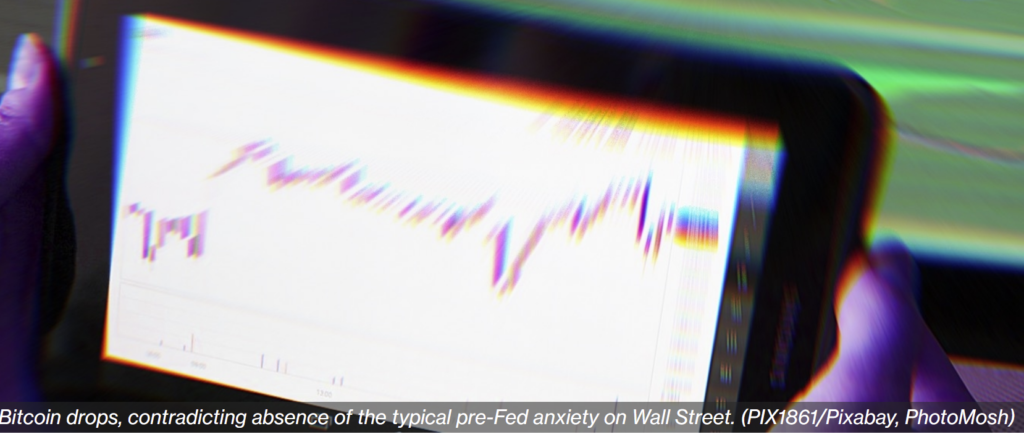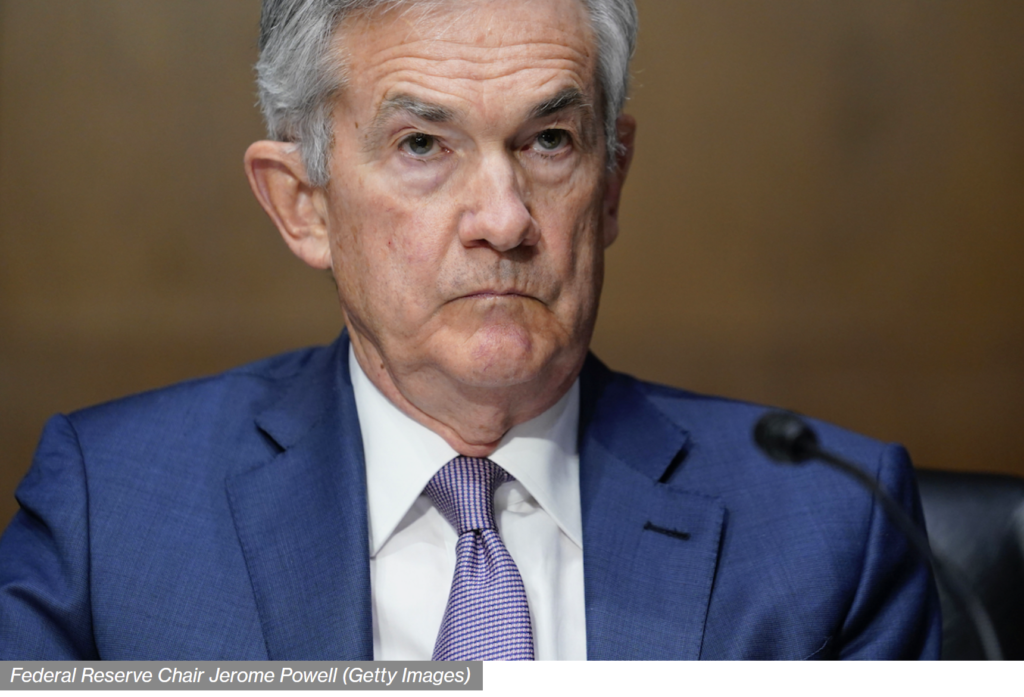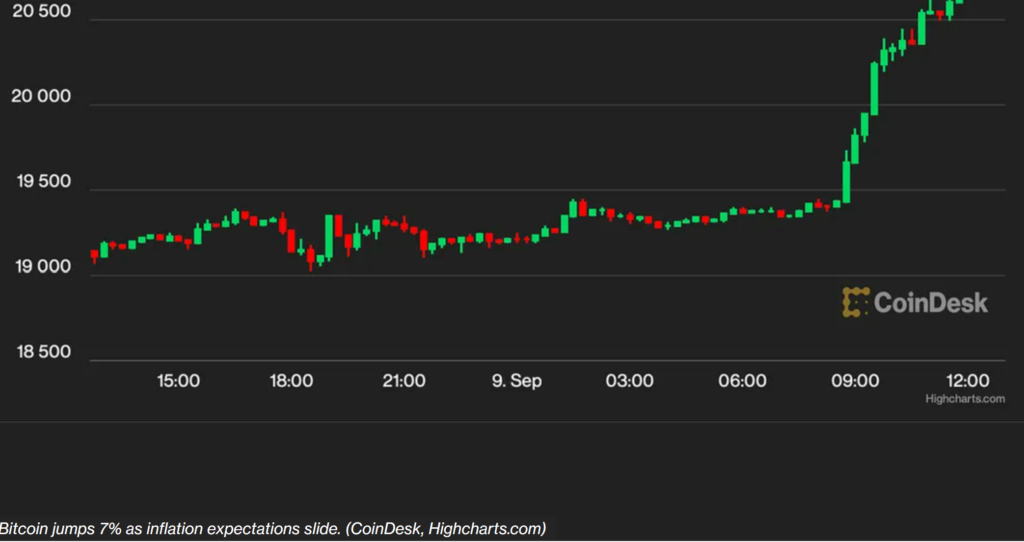Bitcoin Drops Even as Wall Street’s ‘Fear Gauge’ Indicates Calm Ahead of Fed Decision

“I don’t think the hawkish Fed trade has peaked,” one observer said.
Bitcoin fell even as the Chicago Board of Options Exchange’s volatility index (VIX), a measure known as Wall Street’s fear gauge, showed an absence of investor anxiety ahead of an expected U.S. Federal Reserve rate increase on Wednesday.
The top cryptocurrency by market value changed hands near $21,900, down 3.5% in the past 24 hours. The price jumped 8.5% in the seven days through Saturday, the biggest weekly gain since March, alongside gains in stock markets on speculation the Fed may become less hawkish in coming months.
Fed funds futures indicate traders expect the central bank will raise interest rates by 75 basis points this week, with a small likelihood of a 100 basis point move. A basis point is one hundredth of a percentage point.
The price drop is a surprise given the VIX index slipped to 22.41 in early Asian hours, its lowest level since April 21, indicating calm ahead of the Fed rate decision, and S&P 500 futures traded little changed. Bitcoin tends to move in line with risk assets and closely follows sentiment on Wall Street.
Bitcoin’s renewed weakness may be a signal the Fed is set to stick to its path of aggressive tightening. Many traders, including Mobius Capital Partners’ Mark Mobius, consider bitcoin a leading indicator for stock markets.
When the VIX spikes upward, it means investors are buying significantly more put options – or bearish bets – relative to calls – or bullish bets. A rising VIX represents a higher level of concern, while a declining VIX indicates less market fear and stability.

Experts call for caution
Investors could be in for a rude awakening should the Fed stick to a hawkish script.
“With the VIX at 23, it is currently at its lowest level this year, heading into an FOMC (Federal Open Market Committee) meeting, which I find bizarre,” Michael Kramer, founder of Mott Capital Management, wrote in a market update published Sunday, adding that the positioning makes assets vulnerable to a potential Fed shock.
“This complacency may be happening because the market has convinced itself that the Fed is close to pivoting, caving in and going back to its old ways of supporting asset prices,” Kramer noted. “This week’s meeting may change the market’s mind on how serious the Fed is regarding its battle against inflation and that it doesn’t view the economy as weak or heading for a recession.”
Expectations that the Fed is close to opting for smaller hikes for the rest of the year and may eventually reverse course likely stem from signs inflation has peaked and concerns the economy could soon dip into a recession.
“The market seems to be discounting that the Fed will blink in the face of bad economic data and we don’t know that it will – all signaling so far has stressed their focus on inflation, and it’s likely that we’ll see continued determination until either inflation has showed definitive signs of peaking or the economy is in a lot worse shape,” Noelle Acheson, head of market insights at Genesis Global Trading, said. (Genesis is owned by Digital Currency Group, which also owns CoinDesk.)
The Fed has pledged not to let up its policy tightening until inflation moves materially lower toward its 2% annual target. The central bank’s preferred measure of inflation, the core personal consumption expenditure (core PCE) price index, came in at 6.3% for May. Any Fed pivot may also be contingent on a marked decline in the consumer price index, which includes the volatile food and energy component and affects the spending habits of Americans. In June, the CPI soared 9.1% from a year earlier, a 40-year high.
“Although the news on renewed wheat shipments and prices back to pre-invasion levels will help, as will continued downward moves on other commodities, the price increases in the CPI and PCE so far have been broad-based which hints at stickiness,” Acheson said, referring to food exports from Ukraine and its war with Russia.
And while cracks are appearing in the housing sector, the broader economy looks resilient, thanks to strong jobs and wage growth. When it was last reported on June 30, the Kansas City Labor Market Conditions Index was at its highest since the late 1990s. The Atlanta Fed’s wage growth tracker reached its highest since 1997 at the end of June.
The data provides the Fed with room to continue tightening, meaning the so-called hawkish Fed trade, which involves buying dollars and selling risk assets, could continue to roil markets, including cryptocurrencies.
“I don’t think the hawkish Fed trade has peaked,” Acheson told CoinDesk. Since March, the Fed has raised borrowing costs by 150 basis points, lifting the benchmark interest to the 1.5%-1.75% range.
Worst may be over
Although the hawkish trade appears to have legs, other factors may ensure limited downside in crypto.
“The narrative decoupling is likely to become more apparent as global economic fractures widen,” Acheson said. “And there is also the Ethereum Merge trade, the DeFi (decentralized finance) trade and other signs of progress to further distance crypto market performance from stock market performance in coming months.”
David Duong, head of institutional research at Coinbase Global, said the bullish positioning in the dollar appears overdone and could reverse depending on what the Fed signals later this week.
A recently published Bank of America fund manager survey cited long U.S. dollar, long oil and short stocks as crowded trades. Such extreme risk-off or bearish positioning often portends a trend reversal higher. Several indicators have flashed signs of a bear market bottom recently in bitcoin.
That said, according to Duong, a bull revival will take time.
“But even though the worst for crypto is probably over, I think we still need a few more months for things to stabilize before digital assets like bitcoin can start to recover in earnest,” he said.
BY: Omkar Godbole
DISCLOSURE
Please note that our privacy policy, terms of use, cookies, and do not sell my personal information has been updated.
The leader in news and information on cryptocurrency, digital assets and the future of money, CoinDesk is a media outlet that strives for the highest journalistic standards and abides by a strict set of editorial policies. CoinDesk is an independent operating subsidiary of Digital Currency Group, which invests in cryptocurrencies and blockchain startups. As part of their compensation, certain CoinDesk employees, including editorial employees, may receive exposure to DCG equity in the form of stock appreciation rights, which vest over a multi-year period. CoinDesk journalists are not allowed to purchase stock outright in DCG.










